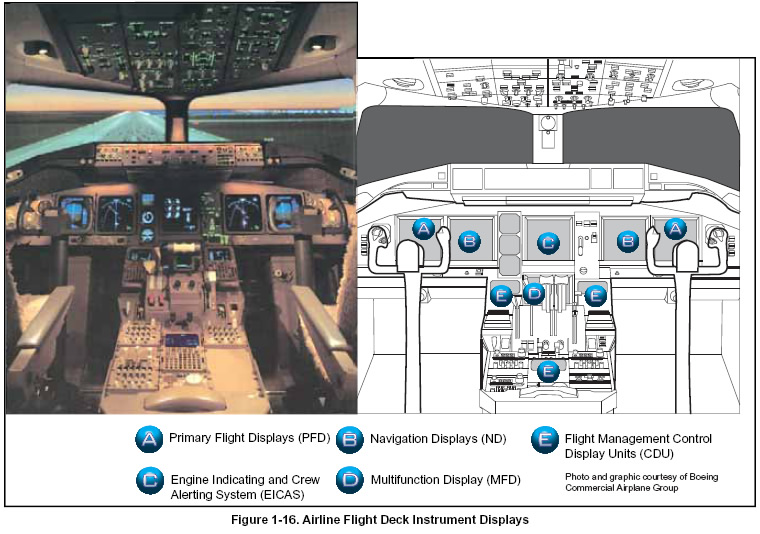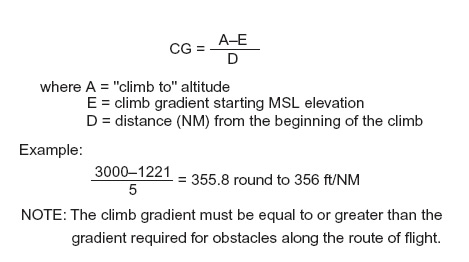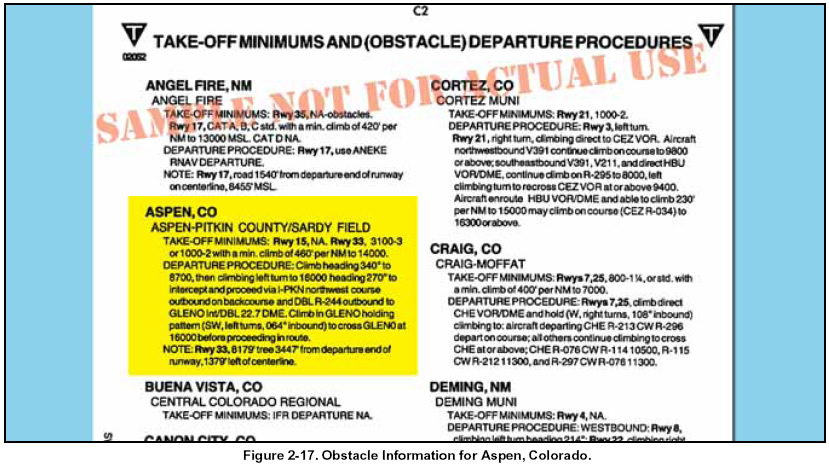 |
|
| INSTRUMENT PROCEDURES HANDBOOK |
|
ALTERNATE MINIMUMS FOR COMMERCIAL OPERATORS IFR alternate minimums for Part 121 and 135 operators are very specific and have more stringent requirements than Part 91 operators. Part 121 operators are required by their OpsSpecs and Parts 121.617 and 121.625 to have a takeoff alternate airport for their departure airport in addition to their airport of intended landing if the weather at the departure airport is below the landing minimums in the certificate holder’s OpsSpecs for that airport. The alternate must be within two hours flying time for an aircraft with three or more engines with an engine out in normal cruise in still air. For two engine aircraft, the alternate must be within one hour. The airport of intended landing may be used in lieu of an alternate providing it meets all the requirements. Part 121 operators must also file for alternate airports when the weather at their destination airport, from one hour before to one hour after their ETA, is forecast to be below a 2,000-foot ceiling and/or less than 3 miles visibility. For airports with at least one operational navigational facility that provides a straight-in non-precision approach, a straight-in precision approach, or a circling maneuver from an instrument approach procedure determine the ceiling and visibility by:
This is but one example of the criteria required for Part 121 operators when calculating minimums. Part 135 operators are also subject to their own specific rules regarding the selection and use of alternate minimums as outlined in their OpsSpecs and Part 135.219 through Part 135.225, and they differ widely from those used by Part 121 operators. Typically, dispatchers who plan flights for these operators are responsible for planning alternate airports. The dispatcher considers aircraft performance, aircraft equipment and its condition, and route of flight when choosing alternates. In the event changes need to be made to the flight plan en route due to deteriorating weather, the dispatcher will maintain contact with the flight crew and will reroute their flight as necessary. Therefore, it is the pilot’s responsibility to execute the flight as planned by the dispatcher; this is especially true for Part 121 pilots. To aid in the planning of alternates, dispatchers have a list of airports that are approved as alternates so they can quickly determine which airports should be used for a particular flight. Dispatchers also use flight-planning software that plans routes including alternates for the flight. This type of software is tailored for individual operators and includes their normal flight paths and approved airports. Flight planning software and services are provided through private sources. Though the pilot is the final authority for the flight and ultimately has full responsibility, the dispatcher is responsible for creating flight plans that are accurate and comply with the CFRs. Alternate minimum criteria are only used as planning tools to ensure the pilot-in-command and dispatcher are thinking ahead to the approach phase of flight. In the event the flight would actually need to divert to an alternate, the published approach minimums or lower-than-standard minimums must be used as addressed in OpsSpecs documents. DEPARTURE PROCEDURES Departure procedures are preplanned routes that provide transitions from the departure airport to the en route structure. Primarily, these procedures are designed to provide obstacle protection for departing aircraft. They also allow for efficient routing of traffic and reductions in pilot/controller workloads. These procedures come in many forms, but they are all based on the design criteria outlined in TERPS and other FAA orders. The A/FD includes information on high altitude redesign RNAV routing pitch points, preferred IFR routings, or other established routing programs where a flight can begin a segment of nonrestrictive routing. DESIGN CRITERIA The design of a departure procedure is based on TERPS, a living document that is updated frequently. Departure design criterion assumes an initial climb of 200 feet per nautical mile (NM) after crossing the departure end of the runway (DER) at a height of at least 35 feet. [Figure 2-15] The aircraft climb path assumption provides a minimum of 35 feet of additional obstacle clearance above the required obstacle clearance (ROC), from the DER outward, to absorb variations ranging from the distance of the static source to the landing gear, to differences in establishing the minimum 200 feet per NM climb gradient, etc. The ROC is the planned separation between the obstacle clearance surface (OCS) and the required climb gradient of 200 feet per NM. The ROC value is zero at the DER elevation and increases along the departure route until the appropriate ROC value is attained to allow en route flight to commence. It is typically about 25 NM for 1,000 feet of ROC in nonmountainous areas, and 46 NM for 2,000 feet of ROC in mountainous areas.
Recent changes in TERPS criteria make the OCS lower and more restrictive. [Figure 2-16 on page 2-14] However, there are many departures today that were evaluated under the old criteria [Figure 2-15] that allowed some obstacle surfaces to be as high as 35 feet at the DER. Since there is no way for the pilot to determine whether the departure was evaluated using the previous or current criteria and until all departures have been evaluated using the current criteria, pilots need to be very familiar with the departure environment and associated obstacles especially if crossing the DER at less than 35 feet.
Assuming a 200-foot per NM climb, the departure is structured to provide at least 48 feet per NM of clearance above objects that do not penetrate the obstacle slope. The slope, known as the OCS, is based on a 40 to 1 ratio, which is the equivalent of a 2.5 percent or a 152- foot per NM slope. As a result, a departure is designed using the OCS as the minimum obstacle clearance, and then by requiring a minimum climb gradient of 200 feet per NM, additional clearance is provided. The departure design must also include the acquisition of positive course guidance (PCG) typically within 5 to 10 NM of the DER for straight departures and within 5 NM after turn completion on departures requiring a turn. Even when aircraft performance greatly exceeds the minimum climb gradient, the published departure routing must always be flown. Airports declaring that the sections of a runway at one or both ends are not available for landing or takeoff publish the declared distances in the A/FD. These include takeoff runway available (TORA), takeoff distance available (TODA), accelerate-stop distance available (ASDA), and landing distance available (LDA). These distances are calculated by adding to the full length of paved runway, any applicable clearway or stopway, and subtracting from that sum the sections of the runway unsuitable for satisfying the required takeoff run, takeoff, accelerate/stop, or landing distance, as shown in Figure 2-16 on page 2-14. In a perfect world, the 40 to 1 slope would work for every departure design; however, due to terrain and manmade obstacles, it is often necessary to use alternative requirements to accomplish a safe, obstacle-free departure design. In such cases, the design of the departure may incorporate a climb gradient greater than 200 feet per NM, an increase in the standard takeoff minimums to allow the aircraft to “see and avoid” the obstacles, standard minimums combined with a climb gradient of 200 feet per NM or greater with a specified reduced runway length, or a combination of these options and a specific departure route. If a departure route is specified, it must be flown in conjunction with the other options. A published climb gradient in this case is based on the ROC 24 percent rule. To keep the same ROC ratio as standard, when the required climb gradient is greater than 200 feet per NM, 24 percent of the total height above the starting elevation gained by an aircraft departing to a minimum altitude to clear an obstacle that penetrates the OCS is the ROC. The required climb gradient depicted in ODPs is obtained by using the formulas:
These formulas are published in TERPS Volume 4 for calculating the required climb gradient to clear obstacles. The following formula is used for calculating climb gradients for other than obstacles, i.e., ATC requirements:
Obstacles that are located within 1 NM of the DER and penetrate the 40:1 OCS are referred to as “low, close-in obstacles.” The standard ROC of 48 feet per NM to clear these obstacles would require a climb gradient greater than 200 feet per NM for a very short distance, only until the aircraft was 200 feet above the DER. To eliminate publishing an excessive climb gradient, the obstacle AGL/MSL height and location relative to the DER is noted in the Take-off Minimums and (OBSTACLE) Departure Procedures section of a given TPP booklet. The purpose of this note is to identify the obstacle and alert the pilot to the height and location of the obstacle so they can be avoided. [Figure 2-17]
Departure design, including climb gradients, does not take into consideration the performance of the aircraft; it only considers obstacle protection for all aircraft. TERPS criteria assumes the aircraft is operating with all available engines and systems fully functioning. When a climb gradient is required for a specific departure, it is vital that pilots fully understand the performance of their aircraft and determine if it can comply with the required climb. The standard climb of 200 feet per NM is not an issue for most aircraft. When an increased climb gradient is specified due to obstacle issues, it is important to calculate aircraft performance, particularly when flying out of airports at higher altitudes on warm days. To aid in the calculations, the front matter of every TPP booklet contains a rate of climb table that relates specific climb gradients and typical airspeeds. [Figure 2-18 on page 2-16]
A visual climb over airport (VCOA) is an alternate departure method for aircraft unable to meet required climb gradients and for airports at which a conventional instrument departure procedure is impossible to design due to terrain or other obstacle hazard. The development of this type of procedure is required when obstacles more than 3 SM from the DER require a greater than 200 feet per NM climb gradient. An example of this procedure is visible at Nervino Airport in Beckwourth, California. [Figure 2-19] The procedure for climb in visual conditions requires crossing Nervino Airport at or above 8,300 feet before proceeding on course. Additional instructions often complete the departure procedure and transition the flight to the en route structure. VCOA procedures are available on specific departure procedures, but are not established in conjunction with SIDs or RNAV obstacle departure procedures. Pilots must know if their specific flight operations allow VCOA procedures on IFR departures.
|






